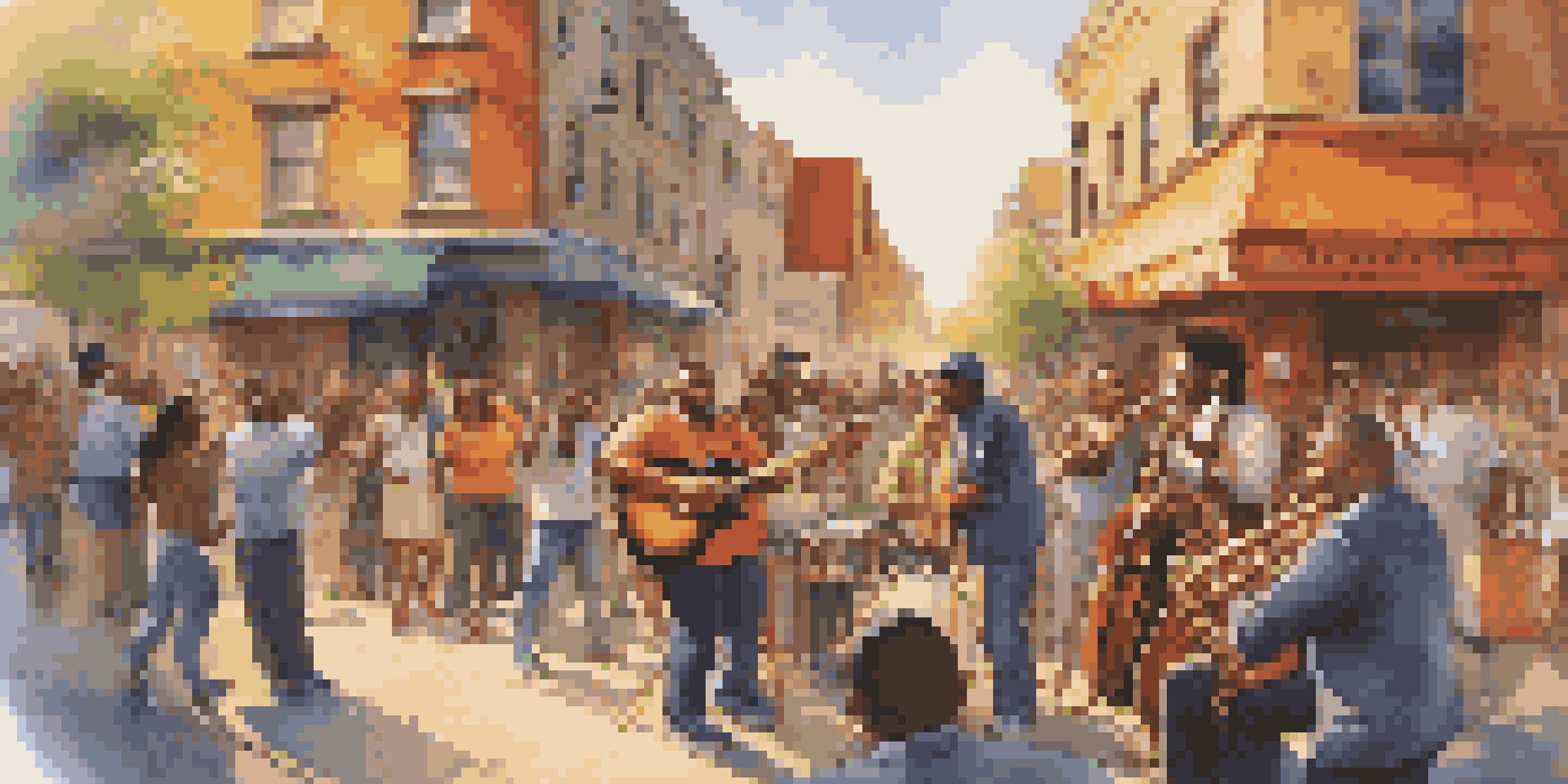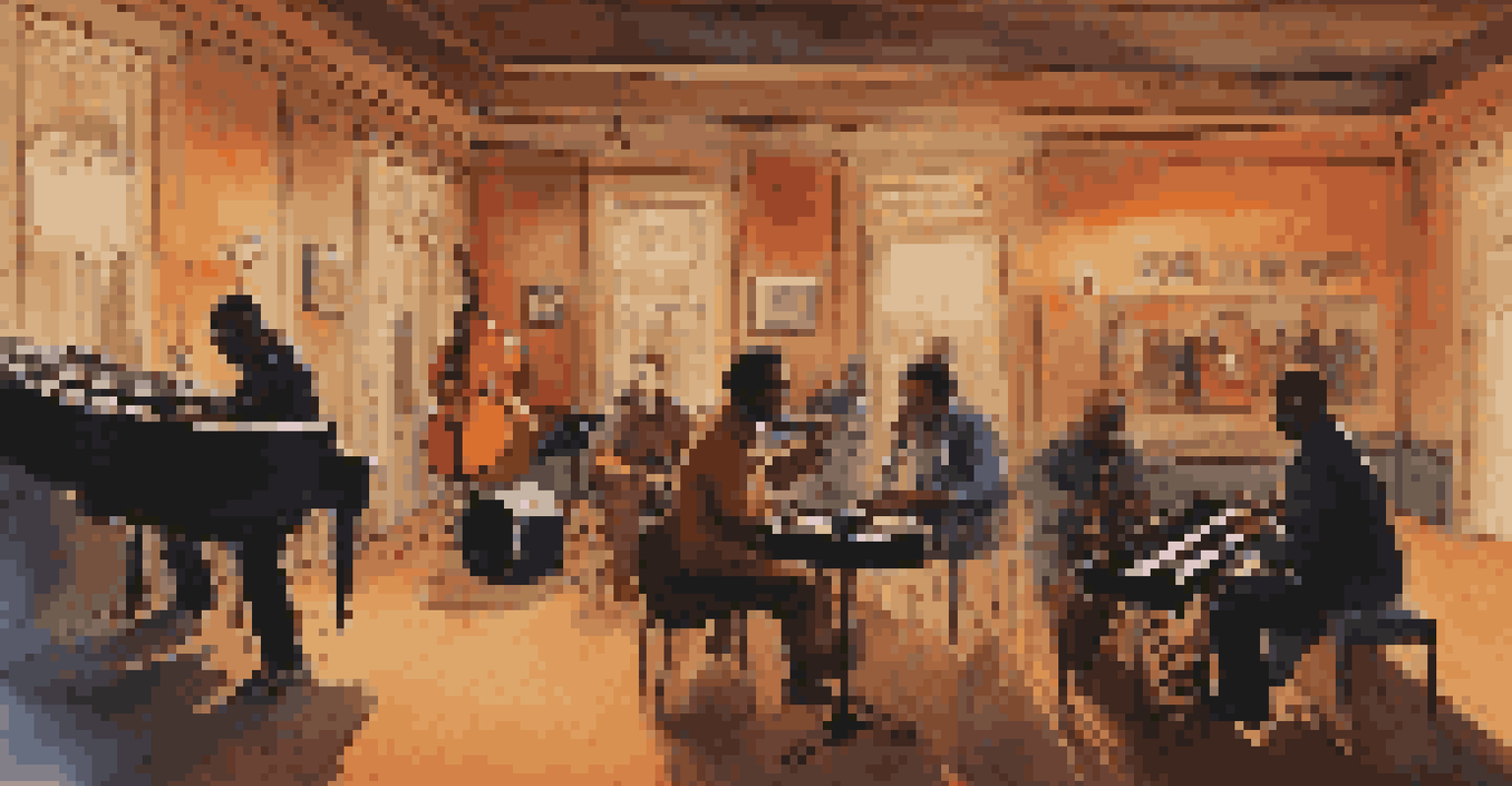Understanding the Blending of Hip-Hop and Jazz Styles

The Roots of Hip-Hop and Jazz: A Historical Overview
Hip-hop and jazz, though distinct genres, share a rich cultural heritage that dates back decades. Jazz originated in the early 20th century, primarily among African American communities in New Orleans, while hip-hop emerged in the 1970s in the Bronx. Both genres reflect the struggles and triumphs of their communities, serving as powerful expressions of identity and creativity.
Jazz is the music of the people, and hip-hop is the voice of the people.
The interplay between these styles began to take shape as artists sought new ways to convey their messages. Jazz's improvisational nature provided a perfect canvas for hip-hop's lyrical storytelling. This historical connection laid the groundwork for the innovative collaborations we see today.
As we explore this fusion, it's essential to appreciate how each genre has influenced the other. Jazz musicians like Miles Davis and John Coltrane have inspired countless hip-hop artists, while hip-hop has breathed new life into jazz, making it accessible to younger audiences.
Key Elements of Jazz That Influence Hip-Hop
Jazz is characterized by its complex chords, syncopated rhythms, and improvisation. These elements have significantly influenced hip-hop production, where beats are crafted to create a unique soundscape. The use of sampled jazz tracks in hip-hop has become a hallmark, giving a fresh twist to classic compositions.

Take, for example, the iconic track 'Jazz (We've Got)' by A Tribe Called Quest. This song seamlessly blends jazz samples with hip-hop beats, creating a rich listening experience that pays homage to both genres. Such examples highlight how hip-hop artists draw inspiration from jazz to enhance their lyrical narratives.
Jazz and Hip-Hop Share Rich Heritage
Both genres reflect the cultural struggles and triumphs of their communities, showcasing a powerful fusion of identity and creativity.
Moreover, the improvisational aspect of jazz aligns beautifully with hip-hop's freestyle culture. Both genres encourage spontaneity and creativity, allowing artists to express themselves in real-time. This connection fosters a vibrant musical dialogue that resonates deeply with audiences.
Notable Collaborations Between Jazz and Hip-Hop Artists
Throughout the years, several artists have exemplified the powerful blend of jazz and hip-hop. One notable collaboration is between jazz trumpeter Roy Hargrove and hip-hop artist Q-Tip, who together created music that transcends genre boundaries. Their work showcases how two seemingly different styles can come together to produce something extraordinary.
Music is a universal language; it transcends boundaries and connects us all.
Another significant figure is the late jazz pianist and producer Robert Glasper, who has been pivotal in bridging the gap between these two worlds. His album 'Black Radio' features collaborations with various hip-hop artists, blending jazz elements with contemporary beats and lyrics. This fusion has garnered critical acclaim, proving that the collaboration can resonate with both jazz aficionados and hip-hop fans alike.
These collaborations not only highlight the versatility of artists but also demonstrate how music can evolve. By merging their unique styles, these musicians have created a new sound that continues to push the boundaries of both genres.
The Impact of Sampling in Hip-Hop and Jazz
Sampling is a crucial aspect of hip-hop, allowing artists to incorporate snippets of existing music into their new creations. This technique often draws from jazz, introducing classic melodies and rhythms to modern beats. The result is a fresh interpretation that pays homage to the original while creating something entirely new.
A prime example of this is found in the song 'C.R.E.A.M.' by Wu-Tang Clan, which samples the jazz track 'As Long As I've Got You' by The Charmels. This strategic sampling not only enriches the song's texture but also connects listeners to the roots of jazz. Such practices have made jazz an integral part of hip-hop's sonic landscape.
Sampling Bridges Jazz and Hip-Hop
Sampling allows hip-hop artists to weave classic jazz melodies into their tracks, creating a fresh sound while honoring the original compositions.
Moreover, sampling jazz allows hip-hop artists to explore deeper emotional narratives. By weaving in the rich history and complexity of jazz, they can elevate their lyrics and themes, creating a powerful connection with their audience. It's a beautiful reminder of how music can transcend time and genre.
The Role of Live Performances in Blending Genres
Live performances play a significant role in illustrating the fusion of hip-hop and jazz. Many artists now incorporate live bands into their shows, creating a dynamic atmosphere that showcases the improvisational elements of both genres. This blend not only enhances the performance but also engages the audience in a unique way.
Artists like The Roots exemplify this approach, as they regularly perform with live instruments, infusing their hip-hop tracks with jazz influences. This synergy allows for spontaneous creativity, making each performance a one-of-a-kind experience. It's a testament to the vibrant relationship between these genres.
Additionally, jazz festivals have begun to feature hip-hop artists, further blurring the lines between the two styles. These events create opportunities for collaboration and experimentation, allowing artists to explore new sounds and styles together. It's an exciting time for both genres, as they continue to evolve and inspire one another.
Cultural Significance of the Jazz-Hip-Hop Fusion
The blending of jazz and hip-hop is not just a musical phenomenon; it carries significant cultural implications as well. Both genres have roots in African American history, serving as a platform for social commentary and expression. The fusion allows artists to address contemporary issues while honoring their cultural heritage.
For instance, many hip-hop artists use jazz influences to tackle themes of inequality, identity, and resilience. This connection creates a powerful narrative that resonates with listeners, bridging generational gaps and fostering understanding. It's a celebration of shared experiences and struggles.
Live Performances Enhance Genre Fusion
The incorporation of live bands in hip-hop performances highlights the improvisational nature of both jazz and hip-hop, creating a unique and dynamic experience.
Moreover, this fusion encourages collaboration across diverse communities, breaking down barriers and fostering unity. By embracing both genres, artists can reach wider audiences and promote a message of inclusivity. It's a beautiful reminder that music has the power to unite us all.
The Future of Hip-Hop and Jazz: Trends and Innovations
As we look to the future, the blending of hip-hop and jazz shows no signs of slowing down. With advancements in technology, artists can experiment with new sounds and production techniques, further enhancing their creative possibilities. This openness to innovation is crucial for the evolution of both genres.
Emerging artists are already pushing the boundaries, incorporating elements from electronic music and other genres into their work. This trend not only keeps the genres fresh but also attracts new listeners. It's an exciting time for music as artists continue to explore and redefine the fusion of hip-hop and jazz.

Moreover, the rise of collaborations between established and emerging artists fosters a vibrant musical landscape. As they share their unique perspectives and experiences, they create a rich tapestry of sound that reflects the diversity of today's society. The future of hip-hop and jazz is bright, promising ongoing innovation and inspiration.